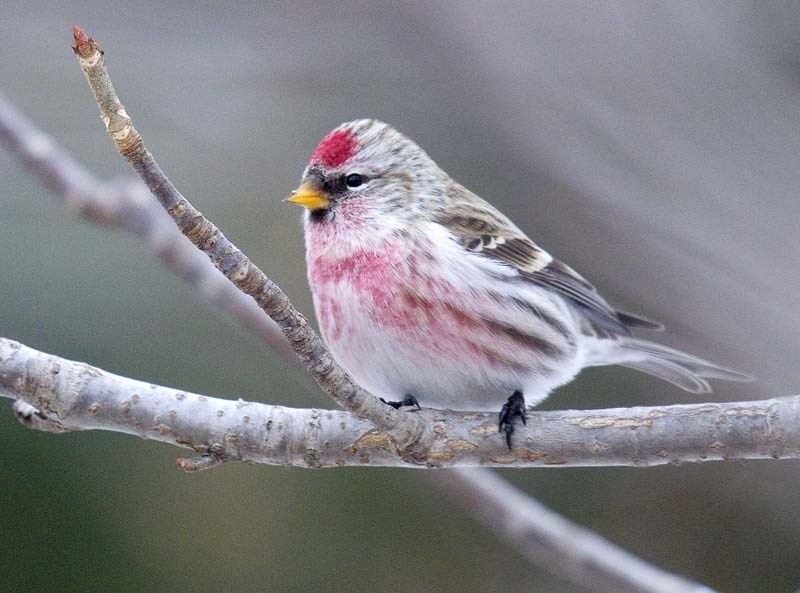Seen any redpolls lately? If you haven't, you're not the only one – for reasons that aren't entirely clear, these tiny, red-capped, zap-happy birds seems to be in short supply around these parts.
Seen any redpolls lately?
If you haven't, you're not the only one – for reasons that aren't entirely clear, these tiny, red-capped, zap-happy birds seems to be in short supply around these parts.
Edmonton got about 2,066 common redpolls during the 2012 Christmas Bird Count, reports Jaynne Carre of the Edmonton Wildbird General Store, but just 144 during the 2013 count held last month. "There have been sightings, but not the numbers of last year."
The theory is that there's currently a lot of food for the redpolls up north in their traditional Arctic stomping grounds, Carre says, so they haven't bothered to move yet. "If they've got good food up north, they'll just eat it and stay."
But they might also have bypassed the Edmonton region and headed to Calgary, she noted. We'll have to wait until all Alberta's Christmas count numbers come in before we know for sure.
Redpolls are tiny, chickadee-sized songbirds known for their conical beaks, brown and white streaky bodies, small black chin and the daub of red on their foreheads, says St. Albert Christmas Bird Count co-ordinator Alan Hingston. The word "pol" comes from the Old English term for "head," he notes, so their name literally means "red-head." Male redpolls will have a patchy red chest that reminds one of a white shirt after a cherry-pie eating contest.
"These aren't necessarily easy birds to distinguish," Hingston notes, as there are a lot of brown streaky birds out there.
The house finch has a red head and chest, for example, but is much bigger and redder. House finches are also brown on the very top of their heads, Carre says, so they look like they're wearing crimson crowns.
Pine siskins are also brown and streaky, notes the Cornell Lab of Ornithology, but have yellow markings on their wings.
And good luck distinguishing the common redpolls from the hoary ones. "Even experienced birders have great difficulty telling them apart," Hingston says, especially since they often flock together.
Hoary redpolls are far less common than common ones, Hingston says – you might see a hundred commons before you see a hoary. If you see a redpoll that looks almost frost-white compared to the ones around it, it's likely a hoary.
Redpolls live throughout the far north, Hingston says, and only come down south here during the winter. When they do, the usually arrive in great numbers, travelling in large, hyperactive flocks that swarm bird feeders.
Expect redpolls to be in almost constant motion, Hingston says, dashing about and scattering at the slightest threat, only to return seconds later. They'll chatter constantly as well – "Zap! Zap! ZrrrrRREEE!" – conducting the auditory equivalent of a Buck-Rogers space battle as they dance about your yard.
Redpolls are known for their cold tolerance, reports the Cornell Lab, known to weather temperatures of -54 C with ease. That's due in part to their thick coat of feathers, which some researchers find bulks up some 31 per cent between July and November.
These birds also have a small throat pouch for seeds, Hingston notes, one researchers think they store food in to snack on during the cold winter nights. Like chickadees, redpolls will also burrow into the snow for warmth. "After snow buntings, redpolls could be the hardiest birds in the world."
While they love birch trees – and usually leave the snow underneath those trees covered with seed debris – Hingston says redpolls are very opportunistic, and will gladly camp out around any food source they find.
Hingston recalls one time at the U of A's experimental farm just north of St. Albert where researchers had dumped a pile of canola just outside resident Bill Bocock's home. "There were literally hundreds if not thousands of redpolls," he says, all gorging themselves on the seed. "That must have been like hitting the jackpot for them."
Try stocking your feeders with niger or shelled sunflower seeds if you want to attract redpolls, suggest Hingston and Carre. But beware: their appetite is insatiable.
"A lot of customers will say they're eating us out of house and home," jokes Carre.
Common redpoll
Name:<br />Acanthis flammea.<br /><br />Appearance: <br />Tiny finch with conical bill for seeds, streaky brown-and-white body, notched tail, little black chin and a red forehead.<br /><br />Commonly seen:<br />Zipping about a feeder with all the agility and sound effects of an X-wing space fighter.<br /><br />Occasionally confused with:<br />House finches, which are redder, bigger and have a red crown; pine siskins, which have yellow on their wings; and hoary redpolls, which look the same but are frost white.<br /><br />Fun fact:<br />They are smart enough to shake the seeds out of birch catkins and eat the seeds that fall on the ground.
Wild St. Albert
Like wildlife? So do we! Every second Wednesday the Gazette profiles a reasonably common wild creature in the St. Albert region. Birds, beasts, bugs, fish … so long as it's alive and kicking, we'll feature it. <br /><br />Got a creature you'd like to see profiled? Send your suggestions to [email protected].




